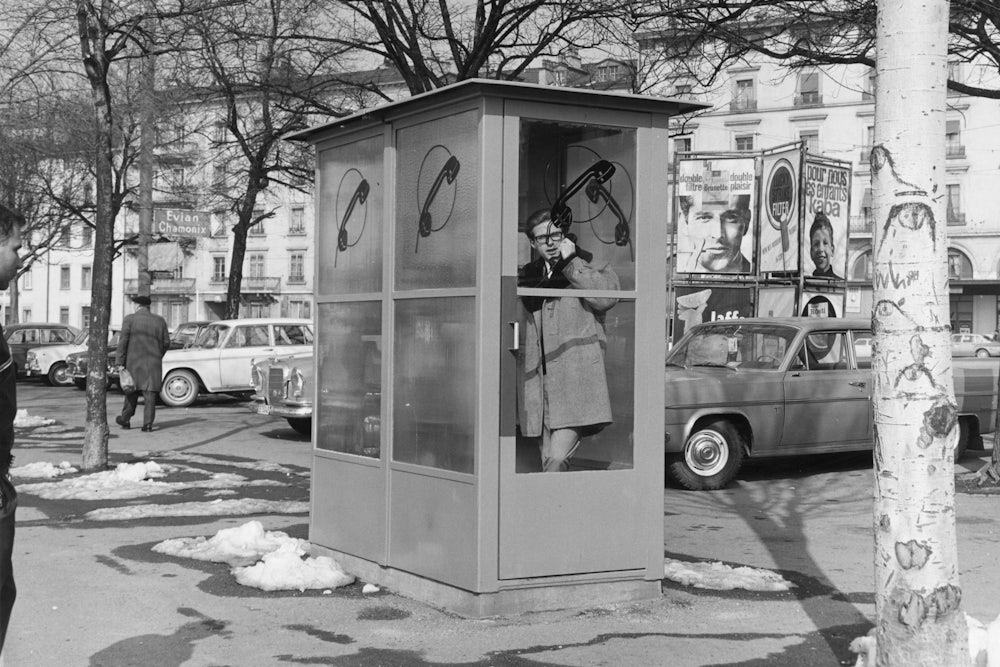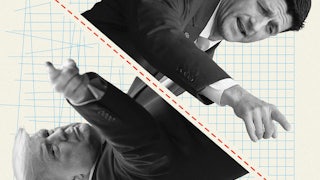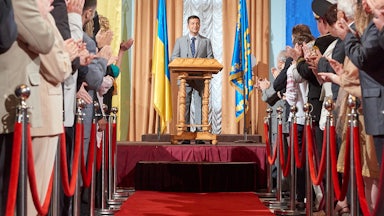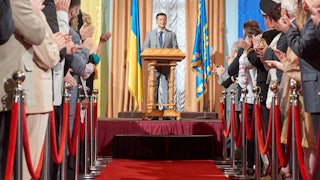In 1911, a self-promoting private detective named William Burns made national headlines. He had broken open a major political corruption case, using a powerful new technology: an electronic bug. A business group had hired him to investigate the Ohio state legislature. So he had two of his agents plant a dictograph—a telephonic device invented in 1905 as an office intercom—under a couch at a hotel in Cincinnati. Another agent then posed as a businessman, invited dozens of legislators to the hotel, and offered them bribes. As lawmakers agreed to the deals, the dictograph carried their conversation to the room next door, where a stenographer wrote it all down. It led to multiple criminal convictions. And Burns became a celebrity: Bars started serving “dictograph cocktails” in his honor, while Burns produced a play about his own exploits and even starred as himself in a silent film. The age of electronic listening had arrived.
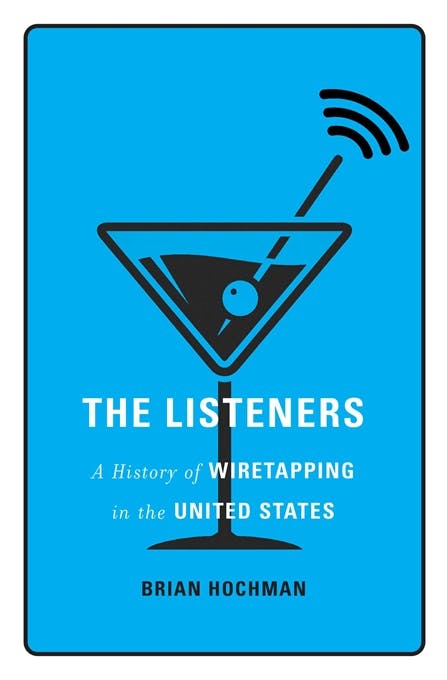
Burns was celebrated for bugging corrupt politicians in Ohio, but he soon drew fire for using a different kind of electronic eavesdropping: tapping phone conversations. In 1916, the first national scandal over wiretapping exploded in New York City, and Burns was in the thick of it. The police were tapping hundreds of phones a year to track criminals and suppress labor activism. Burns was accused of helping them tap the lines at a leading law firm. The public was outraged, and State Senator George Thompson held hearings, where both sides argued their case. Mayor John Mitchell testified that wiretapping was “essential to the protection of the community,” and Burns added that “rough methods” were needed to fight crime. On the other side, labor organizers demanded protection from police surveillance, and civil libertarians warned about the dangers of justifying wiretapping. The hearings offered the public a seemingly stark choice, one that feels all too familiar today: safety or civil liberties?
The Thompson Committee ultimately recommended that New York rein in police wiretapping and prosecute Burns. The detective paid a $100 fine. But it hardly derailed his career: In 1921, he became director of the U.S. Bureau of Investigation, the precursor to the FBI. There, he approved frequent wiretapping, including of a U.S. senator, and in 1924, the ACLU alleged that the bureau was “lawless.” Burns later resigned, but in one of history’s ironies, his successor, J. Edgar Hoover, told Congress in 1929 that the bureau had turned over a new leaf. Wiretapping was “unethical,” Hoover declared, and “any employee engaging in [it] will be dismissed.” That must have slipped his mind in 1963 when he had the FBI tap Martin Luther King Jr.’s phones.
If these wiretapping scandals sound remarkably similar to the controversies over government surveillance today, that’s because they are. Or at least that’s what Brian Hochman argues in his smart, entertaining, and occasionally alarming new book, The Listeners: A History of Wiretapping in the United States. As the subtitle alludes to, Hochman narrates a century and a half of wiretapping, from the Civil War to the War on Terror. What emerges is a powerful prehistory of today’s private sector and government surveillance regimes. Hochman reveals the surprising strength of public resistance to all forms of electronic surveillance until the 1960s. And, crucially, he shows how national leaders used the racial backlash politics of the late 1960s to normalize government eavesdropping and build the world we live in today.
As soon as people started communicating over wires, they worried about wiretapping. Just a year after Samuel Morse sent the first long-distance telegraph in 1844, his attorney and publicist designed a code to keep messages secret. But it was the Civil War, Hochman argues, that really brought wiretapping into its own.
There were 15,000 miles of telegraph lines by the end of the war, and they were easy to tap. You could simply cut into the cable and attach a copper wire with a receiver at the other end. The hard part was not getting caught. Throughout the war, Union and Confederate wiretappers routinely embarked on dangerous missions behind enemy lines, trying to intercept messages and send their own disinformation. Robert E. Lee’s signal clerk even tapped Ulysses S. Grant’s line in 1864, though the only actionable intelligence the Confederates got from it was info on a shipment of Union beef. The pressures of combat also spurred technological innovation, as military telegraphers developed handheld wiretapping devices the size of a cigarette case. And their exploits soon entered the public mind: The Listeners reproduces a fantastic sketch of a Union soldier tapping a Confederate line from Frank Leslie’s Illustrated Newspaper in 1865.
Although wiretapping began as a weapon of war, it quickly lost its association with the government. Instead, Hochman contends, it increasingly came to be seen as a tool of crime. In 1864, D.C. Williams became the first American ever convicted for wiretapping, after he tapped business communications on the West Coast and sent the details to stockbrokers in New York. Newspapers called his case a “new chapter in crime,” and by 1874, a string of other wiretapping cases in New York and Washington, D.C., had alerted the public to the dangers of wire crimes.
Wiretapping was instrumental in a stunning range of crimes. Stock market schemes flourished, and in 1899, commodities speculators even used a wiretap to send false cotton prices to the New Orleans Stock Exchange, setting off a nationwide panic that netted them $170,000. Other crooks used wiretapping to rig sports gambling—they would intercept the results of horse races and then place foolproof bets. There was blackmail and corporate espionage, as well. And in a clever scam that reveals just how aware the public was of wiretapping, con artists in the 1890s invented the “wireless wiretap”: They would tell potential victims that they had a wiretap set up to rig a horse race, then they would take large bets and simply make off with the cash, without ever tapping any lines.
In popular culture, too, wiretapping had a criminal air. Pulp-fiction “wire thriller” novels in the early 1900s, with titles like The Phantom Wires, followed the capers of crooks on increasingly sensational wiretapping sprees. Hochman therefore argues that far from being a clandestine government affair, early wiretapping was driven mainly by private actors—not unlike big tech companies’ surveillance practices today—and those early wiretappers’ stratagems were often well known.
It was Prohibition, in Hochman’s view, that changed wiretapping from a criminal enterprise to a tool for fighting crime. Bootleggers relied on telephones to coordinate shipments of booze, and Prohibition agents quickly started listening in. In the famous Case of the Whispering Wires, hundreds of hours of wiretap transcripts were used to convict Roy Olmstead, the “King of Bootleggers.” On appeal, he argued that Prohibition agents conducted an illegal search in violation of the Fourth Amendment, and when Olmstead v. U.S. made it to the Supreme Court, the federal prosecutor in charge of Prohibition cases refused to argue it, because she “thoroughly disapproved” of “wire-tapping tactics.” Despite her scruples, however, the court upheld Olmstead’s conviction in 1928. It ruled that there had been no illegal search because law enforcement hadn’t physically searched houses or offices. Officials had only listened in.
In a famous dissent, Justice Louis Brandeis argued that Americans have a Fourth Amendment right to privacy on the phone, and subsequent legislation and political debates often leaned toward his view. The Federal Communications Act of 1934, for example, appeared to ban all wiretapping, though the language of the relevant provision was ambiguous. In the 1940s, ACLU director James Fly tried to use the act to shut down all government wiretapping. A series of exposés, like Samuel Dash’s influential 1959 report The Eavesdroppers, also kept government surveillance in the public consciousness. As late as 1969, Hochman notes, fewer than half of all Americans thought the police should never be allowed to wiretap, even with a warrant from a judge.
But
by the mid-1970s, 70 percent thought police should be allowed to listen in. The
debate was effectively over. What happened?
Hochman argues that it was the “law and order” politics of the late 1960s that legitimized police wiretapping—once and for all, in the public mind. In 1967, Senator Edward Long of Missouri, a longtime critic of wiretapping, introduced the Right of Privacy Act. The law would have banned all wiretapping and other forms of electronic eavesdropping. Testifying in support of the bill, Attorney General Ramsey Clark declared that “the wiretap and electronic surveillance” were simply “incompatible with a free society.” That same year, however, the President’s Commission on Law Enforcement—over the dissent of a minority of commission members—recommended giving police the power to use electronic surveillance in routine criminal investigations.
After a fierce contest, the law-and-order perspective won out: Title III of the Omnibus Crime Control and Safe Streets Act of 1968 prohibited all private wiretapping—but it authorized government wiretaps if a judge signed a warrant. That remains the law today, as reflected in pop culture from The French Connection to The Wire. As Lester puts it in season 5, “The case is in the phones, though we’re gonna need a Title III to take a look at them.”
Crucially, both the Omnibus Crime Control Act and the President’s Commission on Law Enforcement were deeply shaped by racial politics. The wiretapping provisions of Title III were the result, to a considerable extent, of racist efforts to control Black communities in the wake of the civil rights revolution. In particular, Arkansas Senator John McClellan, a staunch segregationist, led the charge for Title III. He defended it on the grounds that it would allow the police “to bug a room or hall in which [Stokely] Carmichael was meeting, in which [H. Rap] Brown was meeting.” Dog-whistle claims about crime control were thus mobilized to justify the electronic surveillance of Black activists, and those barely veiled biases helped drive the development of the modern legal architecture for government eavesdropping.
As many scholars have argued, of course, there is a much longer history of state surveillance of African Americans, dating from slave patrols and the Black Codes in the antebellum era to policing under Jim Crow. In the sociologist Simone Browne’s frank assessment, “[S]urveillance is nothing new to black folks.” But the passage of Title III in 1968 marked a new phase in the official deployment of electronic eavesdropping to control the population.
The racial politics of law and order only deepened in the following decades, as the U.S. launched the War on Drugs. Title III wiretapping remained rare in the 1970s, when it was used mainly against gambling. But in 1982, the year Ronald Reagan declared that the government was “running up a battle flag” in a “new campaign against drug abuse,” federal telephone taps increased by 23 percent. They jumped another 40 percent in 1984, and Police Magazine crowed that electronic surveillance was making a “comeback” as a tool to fight narcotics. Hochman thus contends that “[a]s soon as white America came to see inner-city Black communities as ground zero for the nation’s drug problem, wiretapping resurfaced as an acceptable tactic.”
The law-and-order turn that began in the late 1960s and intensified during the war on drugs has had severely disproportionate effects. As the historian Elizabeth Hinton has argued, the President’s Commission on Law Enforcement and the Omnibus Crime Control Act together created a new approach to policing based on “the principle [of] saturating a targeted area with surveillance equipment and police officers.” That strategy, Hinton writes, “eventually criminalized generations of low-income black Americans.” And Title III surveillance, Hochman shows in The Listeners, played a central role in that story.
Title III is still in force today, and in 1978, it was joined by the Foreign Intelligence Surveillance Act, which allows the classified Foreign Intelligence Surveillance Court (FISC) to authorize eavesdropping for national security. The excesses of national security surveillance have generated public outcry in the twenty-first century, especially after Edward Snowden revealed, among other things, that the National Security Agency was collecting certain phone calls and emails as such information traveled through the telecommunications infrastructure. But there is no public debate about Title III surveillance in ordinary criminal investigations. And aside from occasional controversies like the Snowden revelations, the overall program of national security surveillance remains largely unchallenged, too. Both projects—domestic law enforcement eavesdropping and global national security surveillance—emerged amid hyperbolic fears of a racialized other. That surely explains much of the ongoing absence of public debate about their legitimacy.
In some ways, the rise of what critics call “surveillance capitalism” is even harder for the public to recognize and resist. Buried in complex algorithms and opaque user agreements, the proprietors of apps and websites take possession of mountains of personal data and deploy it for corporate profits. As Hochman notes, the legal oversight of such “dataveillance” is feeble at best. Back in 1916, the Thompson Committee held hearings to investigate police wiretapping in New York and propose legislative reforms. We are just at the beginning of a similar reckoning.
Like their twentieth-century predecessors, activists and experts today advocate a range of surveillance reforms, including increased transparency in FISC cases, greater government accountability for illegal eavesdropping, and more protections against government access to personal data held by private companies. Electronic surveillance, however, is almost certainly here to stay. But if Hochman’s book tells us anything, it’s that the cultural norms around wiretapping and the laws that regulate government surveillance have shifted, repeatedly, over time. If we want to change them again, we’ll need to recover the felt sense that wiretapping, in Justice Oliver Wendell Holmes’s words, is a “dirty business.”
